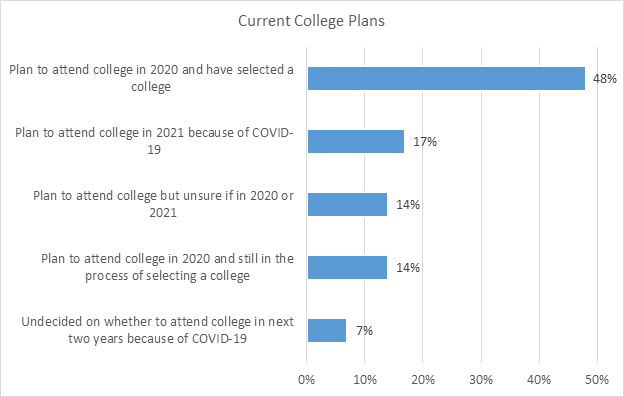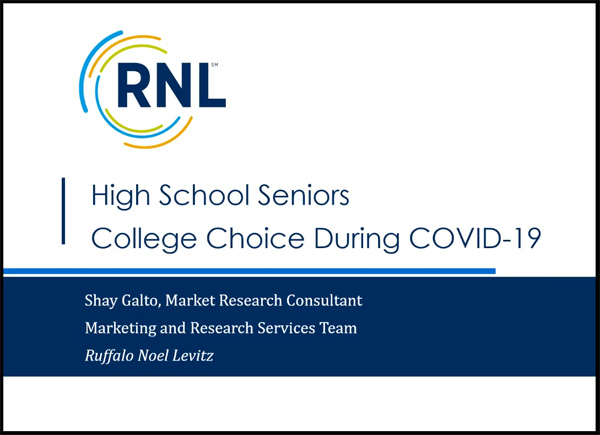enrollment
How Is COVID-19 Affecting Plans for Admitted Seniors?
High school seniors in 2020 have lost a lot. Celebrations and normal rites of passage (prom, graduation, sports, and other award ceremonies) have been canceled or reduced to video meetings. As they look ahead to college, the COVID -19 pandemic creates further uncertainties about what happens next.
Enrollment professionals need to know what actions they can take to maximize yield, even amid these uncertainties. To provide insights, RNL partnered with Dynata to survey more than 530 high school seniors who had originally planned to enroll in college in fall 2020, allowing seniors to speak for themselves. Over two-thirds of respondents indicated the pandemic influenced their college choice, and many are concerned any semblance of the traditional new student experience is slipping away from them.

Seven key takeaways from our survey
- Never stop recruiting. Many seniors who intended to enroll in fall 2020 are now uncertain about both if they will attend and where they will attend. Nearly half plan to attend college and have already selected their school, while 14 percent plan to attend but are still selecting a college. Seventeen percent plan to defer by a year while another 14 percent are considering deferral. Finally, 7 percent are now undecided if they will attend college within the next two years because of COVID-19. To give them time to solidify their choices, 47 percent indicated colleges should postpone common decision deadlines as a response to COVID-19.

Now is the time for institutions to develop creative options that meet the concerns of each student. The points below might be some places to start.
- Be prepared for intensified competition based on price. More than half (53 percent) of high school seniors said they were more concerned about affording college. Of students who were uncertain about their fall 2020 plans, 87 percent reported they wanted to consider more affordable options. This makes sense given increasing unemployment and lost opportunities for many to work during the summer. This is not limited to four-year institutions. When asked about college affordability concerns, more prospective community college students were concerned than their peers who plan to attend a four-year public institution.
It is also notable that since the start of the pandemic, 29 percent of respondents reported receiving changed financial aid offers. Given changes in NACAC rules in addition to the pandemic, we expect students will be receiving a higher number of competitive offers from more institutions. Students are also making calls for reduced tuition. Make sure your admitted students know you are willing to work with them and have policies to adjust aid if their life circumstances change. - Offer online courses and programs as an alternative to deferral. As mentioned previously, up to 31 percent of seniors are planning to defer or are considering deferring their enrollment due to COVID-19. However, 40 percent say having an option to start their first term online makes a college more attractive (this is particularly the case for those who plan to attend a community college).
If your institution has online courses or online programs to offer, point to the benefits of starting their journey with your institution online and then coming on campus during a later semester as the pandemic situation subsides. An online start allows you to begin building a relationship with the student and allows them to begin making progress on their degree potentially at a lower cost. Work with your academic teams to ensure the online courses are of high quality. - Look in your local markets for new opportunities, but do not discount any student based on distance. Forty-three percent of high school seniors reported a campus location close to home is more attractive. Fifty-one percent of respondents who want to attend in fall 2020 but are unsure what institution they would like to attend are only looking to travel within 100 miles of home (a two-hour drive in many locations). Colleges and universities have a new opportunity to promote their strengths to this undecided group which may appear as lost admits or undecided students within a more limited geographic range. Lost admits from previous recruitment cycles might be new transfer opportunities.
New opportunities in local markets do not mean we can assume students are now unwilling to stay on campus. In fact, 53 percent of the full population is looking at college 50 miles away or further. Counselors should be prepared to speak to both the advantages of attending college closer to home or further from home in a whole new way. - Build connections through remote and virtual events. College is a time of forming lifetime friendships and connections. New student orientation frequently provides the context to seed such friendships. Forty-five percent of new students are concerned about not having a traditional new student experience and 42 percent are concerned about a lack of co-curricular activities. Use online events and social media channels to facilitate the development of connections.
- Address student concerns. More than three-fourths of students reported being concerned about the likelihood of contracting COVID-19. Thirty-six percent of respondents reported a location in a major city was less attractive because of the COVID-19 pandemic. Colleges and universities in major cities need to carry an especially heavy burden to explain how they will keep students safe and why the advantages of an urban location are still relevant or compelling.
- Stay in touch! Email, text messaging, and phone are preferred means of contact. Unsure students prefer email and text messages. Students who are confident in their choice prefer email, phone calls, and text messages and want to be communicated with frequently. Your institution should be communicating how current students are being cared for, how the admissions process is changing (especially decision extensions), how new student orientation will be taking place in the fall, and how your institution will be opening in the fall. If those decisions are not yet made, communicate a timeline for when those decisions will be made to reduce a sense of uncertainty.
You have invested a great deal of time and treasure in recruiting the fall 2020 cohort. More than mere numbers, these students represent the lives of future generations your institution hopes to impact. As we move closer to the fall, it will be increasingly important for you to know how the plans of your admitted students are evolving through better data and closer relationships.
We invite you to learn more about the results of this survey

Contact us today to explore opportunities for achieving your enrollment and net revenue goals
Please contact us to learn more about how we can help you maximize your yield through:
- See if your competitor set has changed through a Competition Analysis
- Price Sensitivity research
- Recruitment services
- Financial aid services
